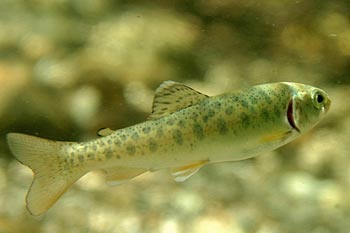Salmon River Restoration Council
- Overview
- Spring Chinook
- Fall Chinook
- Coho
- Steelhead
- Lamprey & Sturgeon
- Program Contact
Overview
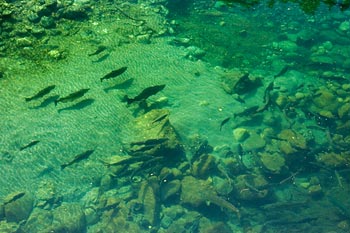
Spring Chinook in the Salmon Riverphoto by Scott Harding
Our Fisheries Program has worked since 1992 to assess, maintain, and restore the Salmon River’s fishery and aquatic ecosystems.
We perform detailed fish population and habitat surveys, participate in a multi-agency fish kill monitoring system, work to prevent fish poaching and fishing regulation violations, and assist academic research projects in our area. All of the SRRC’s formal fishery surveys are planned and coordinated with state and federal agencies and local tribes.
We also host the Spring Chinook Volunteer Recovery Group, a collaborative effort to protect and restore the spring Chinook run on the Salmon River. Seasonally, we operate a juvenile migration screw trap on the lower Salmon River and clear blocked creek mouths throughout the watershed to open their passage to fish.
Importance of the Salmon River Fishery
The Salmon River supports a diverse anadromous fishery of fall and spring run Chinook salmon, coho salmon, summer and winter run steelhead, Pacific lamprey, and green sturgeon. Of these, the spring Chinook, coho, green sturgeon, and both runs of wild Klamath Mountains Province Steelhead are considered to be imperiled.
The Salmon River hosts all runs of anadromous fish found in the entire Klamath River system and retains the last completely wild salmon and steelhead runs in the Klamath watershed. The Salmon River is recognized as an important fish refugia and has the largest remaining wild run of spring Chinook in the Klamath watershed.
In short, the Salmon River is a remnant repository of Klamath River fish genetics and the health and vibrancy of the Salmon River’s fishery is vital to the restoration of the troubled Klamath River fishery.
Spring Chinook
SRRC Program
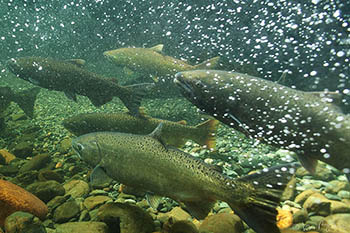 Salmon River Spring Chinookphoto by Michael Bravo
Salmon River Spring Chinookphoto by Michael BravoThe SRRC is intensively involved in the stabilization and restoration of spring Chinook populations in the Salmon and Klamath Rivers.
Since 1995, SRRC has helped organize the annual Spring Chinook and Summer Steelhead Cooperative Fish Dive. This important event entails a crew of 80 trained divers working together to swim the entire Salmon River in a single day to survey the fish population and provide data essential to understanding the health and viability of the fishery. The dive takes place in late July when fish are holed up in deep pools and near cool side streams, making possible an actual count of individual fish.
Spring Chinook spawning, carcass, and redd surveys are conducted in September and October during and after spawning. The SRRC has coordinated these surveys since 2003. We collect tissue samples and otoliths (salmon ear bones) from carcasses to contribute to ongoing research efforts on genetics, stock identification and life history.
Spring Chinook survey data is available in our publications section. More info about our spring Chinook here on the Salmon River is available here. It is a tri-fold brochure.
Species Background
Spring Chinook salmon (Oncorhynchus tshawytscha) were once the most abundant salmonid in the Klamath River system, with annual runs estimated as large as 1,000,000 fish. Historically, the Shasta, Scott, Salmon, and Trinity rivers all supported large runs. Currently, wild spring Chinook runs face the possibility of extinction in the Klamath River watershed.
Current spring Chinook runs on the salmon river are a remnant of their historical size with as few as 80 fish returning some years.
Spring Chinook have subtly different genetics and a substantailly different life history from fall Chinook salmon and, consequently, represent a distinct breeding population. The challenges faced by spring Chinook—many of them related to residing in the river through the hot summer months—are different than those faced by fall Chinook.
Massive Population Declines
In the 19th and early 20th centuries, spring Chinook suffered precipitous declines due to habitat degradation from mining, dams, diversions, and from over-fishing at sea. During this period of history the salmon resource was perceived as inexhaustible and less important than other natural resources, and little concern was given to ensure its viability into the future.
Populations continued to decline throughout the 20th century. The construction of numerous dams on the Klamath River (including Copco 1 & 2, Iron Gate, and JC Boyle), the Trinity River (Lewiston Dam), the Shasta River (Dwinnell Dam), blocked salmon from reaching important spawning grounds and dramatically changed water quality and temperature to the detriment of the fish. The Shasta River run of spring Chinook disappeared coincidentally with the construction of Dwinnell Dam in 1926.
Erosion from logging, related land management activities, and intense wildfires has caused siltation of spawning habitat, further compounding the problem. In short, access to habitat has been severely reduced in the Klamath watershed and the remaining accessible habitat is often degraded.
By the 1980's, spring Chinook were largely eliminated from much of their former range in the Klamath watershed. The current spring Chinook run in the Klamath River system is less than 10% of historic levels. At least seven distinct runs have been eliminated completely.
The Last Viable Wild Run of Spring Chinook Salmon
Today, the Salmon River and the nearby South Fork Trinity River host the last remaining runs of spring Chinook salmon in the Klamath River watershed. The Salmon River run has very little genetic influence from hatchery fish and, for the time being, has a minimally sufficient population to retain its genetically viability, making it exceptionally important to protect and restore these rare fish. Yet, spring Chinook runs on the Salmon River are startlingly small, sometimes with as few as 80 individuals per year. Other years see runs of several hundred. Over a thousand fish is now considered a large run. Overall, the population is on the edge of viability and qualifies for protection as an endangered species.
Tribal Use
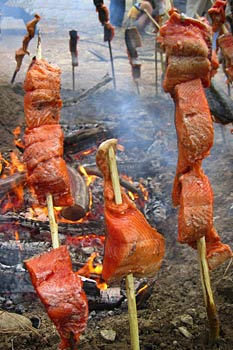
Traditional Karuk salmon bake
Prior to European contact, the Klamath River provided for the needs of the Karuk, Yurok, Hoopa, Konomihu, Shasta, and Klamath tribes with different runs of fish entering the river throughout the year. Spring Chinook were the only salmon available for fishing between late spring and early summer. They are still prized for their superior taste, although their numbers are now greatly diminished, sport fishing in the Salmon River is prohibited, and tribal harvest is limited.
Life History
Until recently, spring Chinook were considered to be genetically identical to fall Chinook salmon and were differentiated only by their life history. New research, however, has revealed that there are small but discernable and important genetic variations between fall and spring Chinook. Importantly, the evolutionary divergence of spring Chinook from fall Chinook occurred long ago and it is now clear that the differences between the two fish is more than their life history and that the likelihood of fall Chinook becoming spring Chinook through behavorial modification is extremely unlikely.
As adults, spring Chinook migrate upstream from the ocean in late spring and early summer while water levels are high, making for an easier journey in cooler water. The fish then reside in the river for the duration of the hot summer months, seeking refuge in deep pools and in the cool water at creek mouths. When the first fall rains raise the river level, the spring Chinook continue their journey upstream to spawning grounds in the upper reaches of the river.
At about this same time, the fall Chinook are just entering the river on their upriver migration. The spring Chinook, however, have already claimed the prized spawning grounds in the upper river. Spawning takes place in early fall. Fry emerge from the gravels beginning in March on into June. Juvenile fish will reside in the river until the summer of the following year and will outmigrate to the ocean in late summer. High temperatures in the Klamath River create substantial stress for outmigrating fish and is believed to cause substantial fish mortality.
Upper Klamath-Trinity River Spring Chinook Salmon on the Endangered Species List
On July 16, 2021 the California Fish and Game Commission voted unanimously to add Klamath Trinity spring Chinook salmon to the endangered species list! This listing is based on a petition that the Karuk Tribe and Salmon River Restoration Council submitted jointly in 2018, after continued decline of this critical salmon population.
This is a monumental win after decades of hard work by countless, dedicated people to get recognition and protection for our iconic spring Chinook salmon. We are immensely grateful to everyone who has been working to protect, honor, and restore these incredibly important and imperiled fish, their habitat, and the cultures and people who depend on them.
While it is hard in many ways to feel positive about a win that enshrines just how imperiled these fish are, we know that this is a significant step in preserving and restoring spring salmon. There is so much yet to do, but today we celebrate! You can read our press release here.
Download the CF&G Commission NOTICE OF FINDINGS Upper Klamath-Trinity River Spring Chinook Salmon December, 2021[PDF]: California Fish and Game Commission warrants adding UKTSCS to the list of endangered species under the California Endangered Species Act
Fall Chinook
SRRC Program
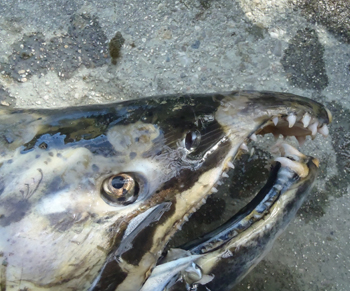
Salmon River fall Chinook carcass
The SRRC participates in the cooperative Mid Klamath River Chinook Spawner Escapement Surveys each year. The Salmon River Chinook Spawning and Carcass Surveys are a cooperative effort between the US Forest Service, California Department of Fish and Game, US Fish and Wildlife Service, Native American tribes, and SRRC. The results are used to determine what next year’s ocean and in-river harvest allocations will be. These surveys take place October-December.
Fall Chinook survey data is available in our publications section.
Species Background
Fall run Chinook salmon (Oncorhynchus tshawytscha) are the most abundant salmonid in the Klamath watershed, including the Salmon River. Historic annual runs of 300,000 to 500,000 adults have been estimated for the Klamath River system. Historically, the fall Chinook run was smaller in size than the spring Chinook run.
Current runs of hatchery and wild fish ranging from about 34,000 to 239,000 with most below years having runs below 150,000. Total run sizes on the Salmon River are variable, ranging between 800 and 6,000 annually.
Massive Population Declines
Primary causes for the decline in fall Chinook populations are linked to dams blocking habitat, previously unregulated harvest, water use and quality, and habitat degradation. The same factors leading to declines of spring Chinook have affected fall Chinook.
Life History
Fall Chinook have a different life history than spring Chinook and use much of the same habitat but generally do not go as far upstream in the river system to spawn.
As adults, fall Chinook migrate upstream from the ocean in late summer to late fall while water levels are generally low. They often “pool up” waiting for water levels to rise with early fall rains so they can continue through rapids and shallow sections of river.
Spawning takes place from October through December, as soon as the salmon have reached their desired spawning grounds. Fry emerge from the gravels beginning in February on into mid-April. Juvenile fish will outmigrate to the ocean in early summer that same year. High temperatures in the Klamath River create substantial stress for outmigrating juvenile fish and is believed to cause substantial fish mortality.
Coho Salmon
SRRC Program
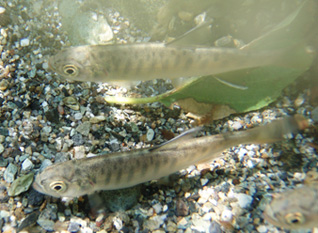
Juvenile coho in the North Fork Salmon River
The SRRC’s coho research and monitoring projects include Salmon River juvenile coho population surveys and Salmon River adult coho spawning and redd surveys. These surveys are completed in cooperation with the Karuk Tribe, US Forest Service and California Department of Fish and Wildlife.
Species Background
Coho salmon are the only fish species in the Salmon River that are currently listed under the Endangered Species Act. They were federally listed as threatened in 1997 and by the State of California in 2002.
Coho salmon (Oncorhynchus kisutch) populations have declined significantly over the past 40 to 50 years. Total coho populations, including hatchery stocks, has declined at least 70% since the 1960’s, and is currently approximately 6% of its historic size. The Klamath River system’s coho runs were estimated at 15,000 fish per year in the 1960’s.
They are very scarce in the Salmon River today, with no more than a handful of adult spawners seen most winters. According to the California Coho Recovery Strategy, the Salmon River historically had approximately 105 miles of coho salmon habitat. More recent estimates suggest that coho now have access to approximately 85 miles of habitat. The Salmon River likely supported a population of several thousand coho salmon in the past. The number dropped precipitously in the last two decades; presently annual adult returns are likely less than 50 per year.
Life History
Coho salmon migrate upstream into the Klamath River in September through January. Spawning takes place in mid-November to February. Frys emerge from the gravels from February to mid-May. Juvenile coho reside in the river for 12 to 18 months before outmigrating to the ocean. Most adults return in three years.
Coho are distinct in their use of rearing habitat, preferring lower gradient habitat and deeper pools than other salmonids. They are especially sensitive to water temperature. Over-wintering habitat is especially critical for this species.
Steelhead
SRRC Program
SRRC conducted winter steelhead spawning surveys in March and April for many years. The results provide vital data for assessing relative steelhead ranges and populations within the watershed. In more recent years, surveys have been cut back and focus primarily on monitoring tributaries with active or recent restoration projects.
Steelhead migration barriers are also identified and recorded to assist in the development of fish passage improvement projects.
Summer steelhead population counts are made each year during the spring Chinook and summer steelhead dive. Those annual population totals can be found on the Publications page.
Species Background
Steelhead (Oncorhynchus mykiss) are the most widely distributed salmonid in the Salmon River system. They are genetically identical to rainbow trout but have an ocean-going life history that causes them to grow much larger and undergo changes in body structure.
Two basic steelhead life-history strategies occur in the Klamath watershed: summer steelhead (stream-maturing) and winter steelhead (ocean-maturing). Both are part of the Klamath Mountains Province Steelhead Evolutionary Significant Unit.
Winter steelhead in the Klamath watershed are in low abundance and at some risk of extinction and are currently listed under the Endangered Species Act. The Salmon River population appears relatively stable. Summer steelhead have declined precipitously over the last 30-40 years on the Salmon River due to historic mining, the 1964 flood and possibly unfavorable ocean conditions from the mid-to-late ‘80s through the early ‘90s. With the addition of historic timber harvest impacts, it is probable that these impacts have resulted in a decline in winter steelhead as well (Moyle et al., 2015).
Life History
Summer steelhead migrate upstream into the Salmon River system between May and June, holding over in deep pools until spawning begins in December through February.
Winter steelhead enter the Salmon River from September through November and enter the smaller tributary streams as late as April. Spawning occurs from December through April.
Steelhead, unlike salmon, are repeat spawners, returning to the ocean after spawning in the river, then coming back to the river again to spawn, sometimes for several years.
Freshwater residency for summer steelhead ranges from one to three years, but in the Salmon River is predominantly two years. They appear to outmigrate year-round, with a peak from March through June, along with the winter steelhead.
Notable to the Klamath River watershed is the half-pounder, which are immature fish that migrate to the ocean in spring but return to spend the next winter in fresh water.
Pacific Lamprey & Green Sturgeon
Pacific Lamprey
SRRC Program

Pacific lamprey in the Salmon River
The SRRC’s Pacific lamprey monitoring activities have included surveying known and suspected habitats in Salmon River watershed for lamprey presence, and assisting the Karuk Tribal Fisheries Program in sampling lamprey ammocetes.
Species Background
Pacific lamprey (Lampetra tridentata) are the only anadromous species of lamprey in the Klamath watershed. The lamprey, also known as “eels”, are a jawless fish with a toothed, funnel-like sucking mouth used to bore into the flesh of other fish. They are dark blue or brown in color and grow to about 30 inches (76 cm) in length.
Pacific lamprey are in decline in the Klamath River system. Population declines are the result of various factors, including habitat alteration and destruction, migration barriers, dredging, decreased river flows, and pollution. Pacific lamprey have been considered for listing under the Endangered Species Act.
Tribal Use
Lamprey have been a traditional staple food for the Karuk Tribe. They were traditionally harvested in March through June and provided a vital source of sustenance in the season before the spring Chinook run began.
Life History
Pacific lamprey live along the Pacific Coast of North America and Asia and migrate up rivers to spawn.
Lamprey eggs hatch in two to three weeks. The fry swim to areas of low stream velocity where sediments are soft and rich in dead plant materials. They quickly burrow into the muddy bottom where they filter the mud and water, eating microscopic plants and animals. The juvenile lamprey will stay burrowed in the mud for four to six years, moving only rarely to new areas.
After a two month metamorphosis, which is triggered by unknown factors, they emerge as adults averaging 4.5 inches long. Then, during high water periods in late winter or early spring, they migrate to the ocean. While in the ocean, the lamprey are scavengers or parasites on larger fish such as salmon and even marine mammals. After two to three years in the ocean they return to the river to spawn. Adults die within four days of spawning.
Green Sturgeon
SRRC Program
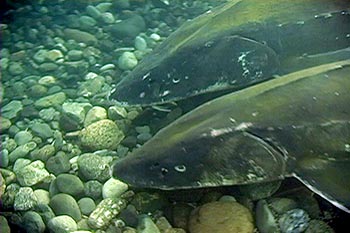
Green sturgeon in the Salmon River
The SRRC has participated in several green sturgeon monitoring activities including population dives on the lower three miles of the Salmon River, larval sampling, and radio telemetry. These projects are the cooperative effort of the US Forest Service, California Department of Fish and Game, US Fish and Wildlife Service, Native American tribes, and SRRC.
Species Background
The green sturgeon (Acipenser medirostris) is a large, olive-green, bony plated, prehistoric-looking anadromous fish, with a shovel-like snout and vacuum cleaner-like mouth used to siphon food from the river bottom. They can reach 7½ feet in length and weigh up to 350 pounds. They are among the longest-lived of all freshwater fish, reaching up to 70 years of age.
Population Decline
The only spawning populations of green sturgeon remaining in California are in the Sacramento and Klamath River systems. Historic over-fishing was a major cause of decline of the species. The large size and sluggish nature of sturgeon make them easy to net and snag.
Present fishing practices continue to deplete a stock of large, old sturgeon that cannot renew itself at current harvest rates. The principal fisheries for green sturgeon are in southern Washington and in the Columbia River estuary, yet there is no evidence of sturgeon spawning in that region. The northern population of green sturgeon (including those in the Salmon River) are listed as a Species of Concern by the National Marine Fisheries Service.
Tribal Use
Green sturgeon are a traditional subsistence food for Klamath River tribes including the Yurok, Karuk, and Hoopa. Today, there is a minimal subsistence fishery for green sturgeon. The Yurok Tribe Fisheries Department has placed restrictions on the number of sturgeon that can be harvested by Yurok fishermen on the Klamath River.
Life History
Green sturgeon range in the ocean from Alaska to Mexico and feed in estuaries and bays from San Francisco Bay to British Columbia. They spawn in the mainstem of large rivers. The presence of juvenile sturgeon far upstream in the Klamath River system suggests that adults will swim far inland to spawn. Green sturgeon have been documented spawning in the Salmon River and juveniles are found in the SRRC’s juvenile outmigration fish trap.
Program Contact
Sophie Price
Fisheries Program Manager
Salmon River Restoration Council
PO Box 1089
25631 Sawyers Bar Road (shipping only)
Sawyers Bar, CA 96027
phone: 530-462-4665
fax: 530-462-4664


Salmon River Restoration Council
PO Box 1089 | Sawyers Bar, CA | 96027
Salmon River (California)
530-462-4665
![]()
